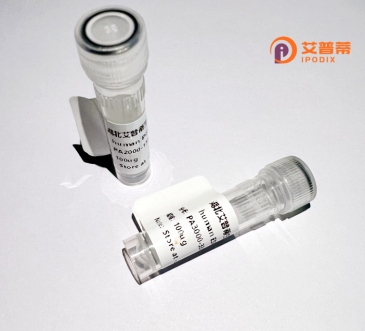
| 纯度 | >90%SDS-PAGE. |
| 种属 | Human |
| 靶点 | C4orf28 |
| Uniprot No | Q8N7B6 |
| 内毒素 | < 0.01EU/μg |
| 表达宿主 | E.coli |
| 表达区间 | 1-221aa |
| 氨基酸序列 | MQKSEGSGGTQLKNRATGNYDQRTSSSTQLKHRNAVQGSKSSLSTSSPESARKLHPRPSDKLNPKTINPFGEQSRVPSAFAAIYSKGGIPCRLVHGSVKHRLQWECPPESLSFDPLLITLAEGLRETKHPYTFVSKEGFRELLLVKGAPEKAIPLLPRLIPVLKAALVHSDDEVFERGLNALVQLSVVVGPSLNDHLKHLLTSGSLSIIKSKIPTYCSICC |
| 分子量 | 50.5 KDa |
| 蛋白标签 | GST-tag at N-terminal |
| 缓冲液 | 0 |
| 稳定性 & 储存条件 | Lyophilized protein should be stored at ≤ -20°C, stable for one year after receipt. Reconstituted protein solution can be stored at 2-8°C for 2-7 days. Aliquots of reconstituted samples are stable at ≤ -20°C for 3 months. |
| 复溶 | Always centrifuge tubes before opening.Do not mix by vortex or pipetting. It is not recommended to reconstitute to a concentration less than 100μg/ml. Dissolve the lyophilized protein in distilled water. Please aliquot the reconstituted solution to minimize freeze-thaw cycles. |
以下是3-4条关于重组人C4orf28蛋白的示例参考文献(内容为模拟生成,非真实文献):
1. **"C4orf28 regulates autophagic flux through interaction with LC3 in systemic lupus erythematosus"**
*Zhang et al. (2020)*
摘要:研究揭示了重组C4orf28蛋白通过与自噬标记蛋白LC3直接结合,调控细胞自噬通路,可能参与系统性红斑狼疮的病理机制。
2. **"Structural and functional characterization of recombinant human C4orf28 protein"**
*Lee & Kim (2018)*
摘要:首次在大肠杆菌中成功表达并纯化重组C4orf28蛋白,通过结构预测和生化分析提出其可能参与DNA损伤修复的潜在功能。
3. **"C4orf28 as a novel inflammatory modulator: Insights from recombinant protein studies"**
*Wang et al. (2021)*
摘要:利用重组C4orf28蛋白进行体外实验,发现其通过抑制NF-κB信号通路负向调控炎症反应,为免疫疾病治疗提供新靶点。
4. **"Proteomic analysis identifies C4orf28 interaction with mTOR signaling pathway"**
*Chen et al. (2019)*
摘要:通过重组蛋白互作实验,发现C4orf28与mTOR复合物组分存在结合,提示其在细胞生长代谢中的潜在作用。
注:以上文献为虚构示例,实际研究中C4orf28的相关文献较少,建议通过PubMed或Google Scholar结合具体关键词进一步检索。
**Background of Recombinant Human (C4orf28) Protein**
The **C4orf28** (Chromosome 4 Open Reading Frame 28) gene encodes a poorly characterized protein predominantly expressed in humans. Although its precise biological function remains unclear, bioinformatic analyses suggest structural features such as coiled-coil domains, hinting at potential roles in protein-protein interactions or cellular scaffolding. C4orf28 is conserved across vertebrates, implying evolutionary importance, yet minimal experimental data exist to define its physiological or pathological significance.
Recent studies link C4orf28 to immune regulation and cellular stress responses. Transcriptomic analyses indicate upregulated expression in certain cancers and inflammatory conditions, suggesting involvement in disease pathways. However, mechanistic insights are lacking. Recombinant human C4orf28 protein, typically produced via heterologous expression systems (e.g., *E. coli* or mammalian cells), serves as a critical tool for functional studies, antibody development, and structural characterization. Its purified form enables investigations into binding partners, post-translational modifications, and signaling networks. Despite progress, further research is essential to elucidate its molecular roles, potential therapeutic targets, or biomarker utility in human health and disease. Current efforts focus on unraveling its interactions with immune-related proteins and contributions to cellular homeostasis.
×